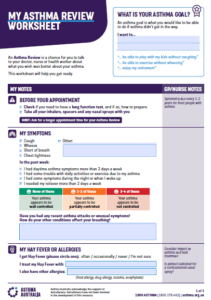Asthma support for children
No matter where you live, we want your child to have access to safe, quality asthma care.
Safe, best-practice asthma care can reduce the risk of your child having an asthma flare up. Here are six asthma basics to help keep your child’s asthma under control all year round.
1. Your child’s own written Asthma Action Plan
A written Asthma Action Plan is one of the most important tools for anyone with asthma. Your child will need a copy for home, school and any other activities they do.
2. The right medicines to prevent and relieve their symptoms
There are two key asthma medicines – most children will need both.
 Relievers: Everyone needs a reliever. They are sometimes called a rescue inhaler or blue puffer. They relax the airways to relieve symptoms.
Relievers: Everyone needs a reliever. They are sometimes called a rescue inhaler or blue puffer. They relax the airways to relieve symptoms.
Preventers: Many children will need a preventer as well. This is low-dose inhaled corticosteroid. They work to calm down your child’s airways to stop symptoms from happening in the first place.
3. Regular asthma reviews – every 6 months
Your child needs an asthma review with their doctor every six months, even when they are not sick. This should be a pre-booked appointment where you have time to talk to the doctor about their Asthma Action Plan, symptoms, triggers and current control.
We recommend booking one at the start of the school year to have their Asthma Action Plan updated and one in winter to check on your child’s asthma during cold and flu season.
Download our Asthma Review Worksheet to help you plan your child’s appointment.
 |
||
4. Check your child’s asthma control
Asthma control is a way to measure how many symptoms your child is having, and how often. Often, asthma control can change with the season. Asthma flare-ups increase around the start of the school year, and when viruses are spreading. Asthma control can also vary depending on other triggers they are exposed to, such as pollen and smoke.
Learn about other possible triggers here.
Check your child’s asthma control
5. Check your child’s technique
No matter how old they are, if your child has an inhaler, they need to know how to use it properly. If their inhaler is a puffer, they should always use a spacer with it. Your doctor or pharmacist can check they have the right technique.
 |
 |
Most children under four will need to use a mask with their spacer, until they learn to seal their lips properly.
We have videos to watch and learn how to use different types of inhalers.
6. Learn what to do in an asthma emergency
Even when your child’s asthma is well controlled, there is still a chance that they could be exposed to something that triggers their asthma. If your child has an Asthma Action Plan already, it will have instructions for Asthma First Aid which may be specifically written for them.
If not, you can follow the standard Asthma First Aid steps, which are safe for all ages.
Note for familiesYou’re doing an amazing job learning about asthma for your child. We know you might still have questions, so feel free to call us now on 1800 ASTHMA (1800 278 462), or book a call below to speak to our Asthma Educators. |










